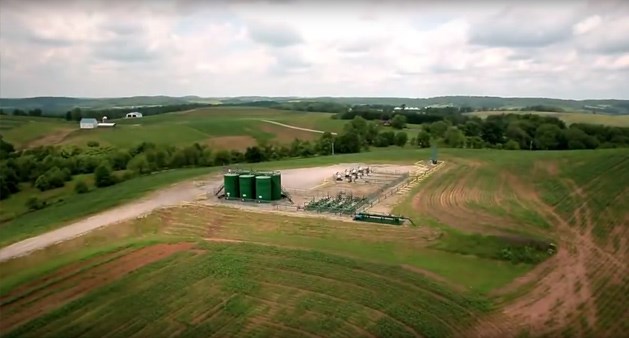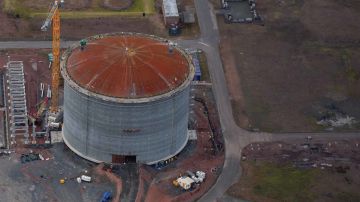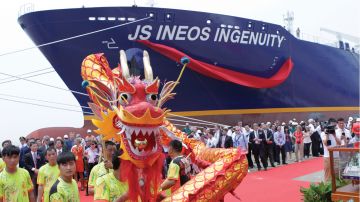INEOS’ decision to pursue shale gas exploration in the UK has set it on a collision course with environmentalists and protest groups. But INEOS is not one to run from a challenging situation especially when it believes it is the right thing to do.
INEOS is now officially the third largest shale gas company in the UK.
Its deal with IGas – announced in March and finalised in May – has now given it access to almost a quarter of a million acres of potential shale gas reserves in Scotland and the North West of England.
“These are first-class assets that have the potential to yield significant quantities of gas in the future,” said Gary Haywood, CEO of INEOS Shale.
In August INEOS was awarded three additional shale gas licenses from the UK Government. The additional acreage cements INEOS position as one of the UK’s leading shale gas businesses.
The company believes an indigenous shale gas industry will revolutionise manufacturing in Britain (currently one of the most expensive places in the world to make petrochemicals), give the UK energy security for the first time in many years, and create thousands of jobs.
But public support remains a challenge for this nascent industry across the UK.
In March INEOS had been buoyed by a Greenpeacesponsored survey which revealed more people in the UK supported fracking than opposed it.
“It clearly showed that more and more people are seeing the potentially huge benefits of UKproduced shale gas,” Tom Crotty, INEOS CorporateAffairs Director, said at the time. “UK shale gas is a once-in-a-lifetime opportunity that we cannot afford to miss. North Sea oil created great wealth for the UK and shale gas can do the same.”
Opponents of fracking claim it is dangerous and disruptive, triggers earthquakes, contaminates drinking water and the air we breathe.
Supporters say – done properly – it is safe, provides countries with a valuable domestic resource, creates jobs, underpins manufacturing and will help to cut CO2 emissions.
America is already proof of that. There, fracking has led to a manufacturing renaissance, created thousands of jobs, driven more than $150 billion worth of investment – and helped to slash US carbon emissions by displacing coal, which emits twice as much CO2 as gas. In 2012 energy-related CO2 emissions, according to the national Energy Information Agency, fell to their lowest level since 1994 because of shale.
In April and May this year INEOS met with local residents for the first time, as part of a concerted effort to explain the facts around shale gas development, and answer the questions posed by people in the Scottish local communities which would be directly affected.
“There will always be a hard core of opponents who are philosophically opposed to fossil fuel development, despite shale gas having only half the carbon footprint of coal,” said Gary. “However, many local residents fear shale development for more local reasons – and these are the people INEOS wants to address, to reassure them of the impacts of shale development. We believe that most people are open-minded about shale development, but want more information. It is an important part of our job to give people the facts, so they can make an informed decision on whether shale gas can happen safely and successfully within their communities – which we very much believe it can.”
The meetings achieved their goal and communities appreciate the opportunity to hear from INEOS first hand, and the opportunity to get their questions answered.
The team will be following up the first set of public meetings with exhibition-style events in Scotland in September.
“Reassuring people that the industry can operate without long-term damage to the environment or their way of life is critical,” said Gary. “It is also vitally important to make the case for why shale gas development is beneficial for communities, and for the country.”
Shale gas is widely viewed as the most important bridge to any future renewable – and affordable – energy source because of its low carbon footprint – half that of coal.
As it stands, rising energy costs in Europe threaten to undermine the ability of manufacturers in the EU to compete on the world stage.
The UK is currently losing jobs to the US where they have access to cheap gas, thanks to shale. In an attempt to protect its UK petrochemical business before it’s too late, INEOS is already investing $1 billion to import shale gas from America to make its site in Grangemouth profitable and to enable the long-term growth of its site at Rafnes (Norway). In a world first, those shipments of liquefied ethane will begin arriving in Rafnes later this year, and into Scotland next.
“Our success in the UK depends on access to competitive energy and feedstock supplies,” said Tom. “Having access to more competitivelypriced feedstock and energy would transform the fortunes of the UK petrochemicals industry and help it to compete in a global market.”
It is hard to believe that Britain – as the founder of the industrial revolution – was once the powerhouse of world trade.
Today manufacturing in the UK is perceived as an industry of the past and has steadily declined with the loss of more than three million jobs over the past 20 years alone.
Yet the chemical industry is even more relevant – and important than ever in helping to create a greener economy – today.
Although it may still rely on fossil fuels to run its plants, it is estimated that for every ton of CO2 it uses, more than two tons are saved by its products, which include catalysts, insulation, components for wind turbines, and solar cells.
Drilling for shale gas may be a new venture for INEOS in the UK, but the INEOS team is being guided by three world-leading pioneers who led the development of the first commercial shale play in the US, the Barnett Shale. Since the development of the Barnett, they have gone on to work on many other shale plays in the US and around the world.
Petroleum engineer Nick Steinsberger and geologists Kent Bowker and Dan Steward, who are now working exclusively for INEOS in Europe, have more than 20 years of industry experience. They have drilled thousands of shale wells without encountering any major issues and will be advising INEOS on how best to safely access Britain’s vast reserves.
“We believe our knowledge and experience in running complex petrochemical facilities, coupled with the world-class, sub-surface expertise we recently added to our team, means that INEOS will be seen as a very safe pair of hands,” said Gary.
He added: “Shale gas is not about short-term speculation for us. It is about securing our manufacturing base which provides thousands of jobs in regional economies.”
For information about shale gas visit:
www.ineosupstream.com


















